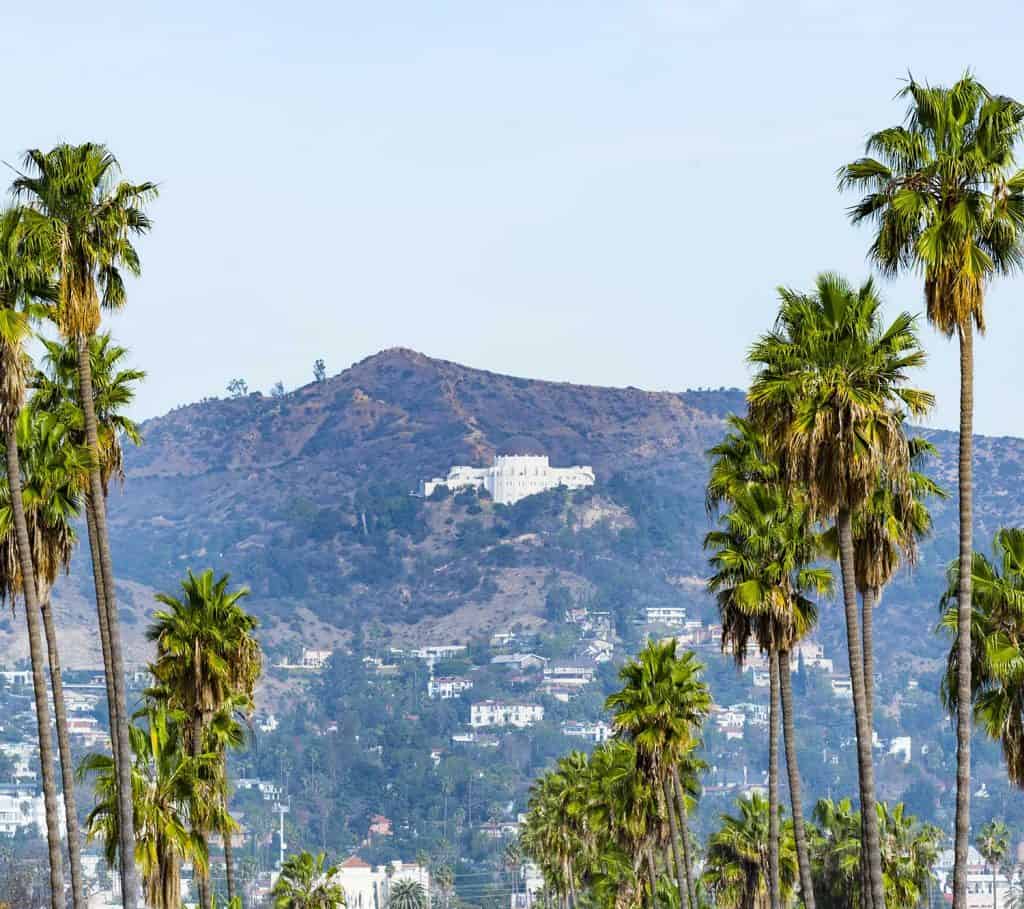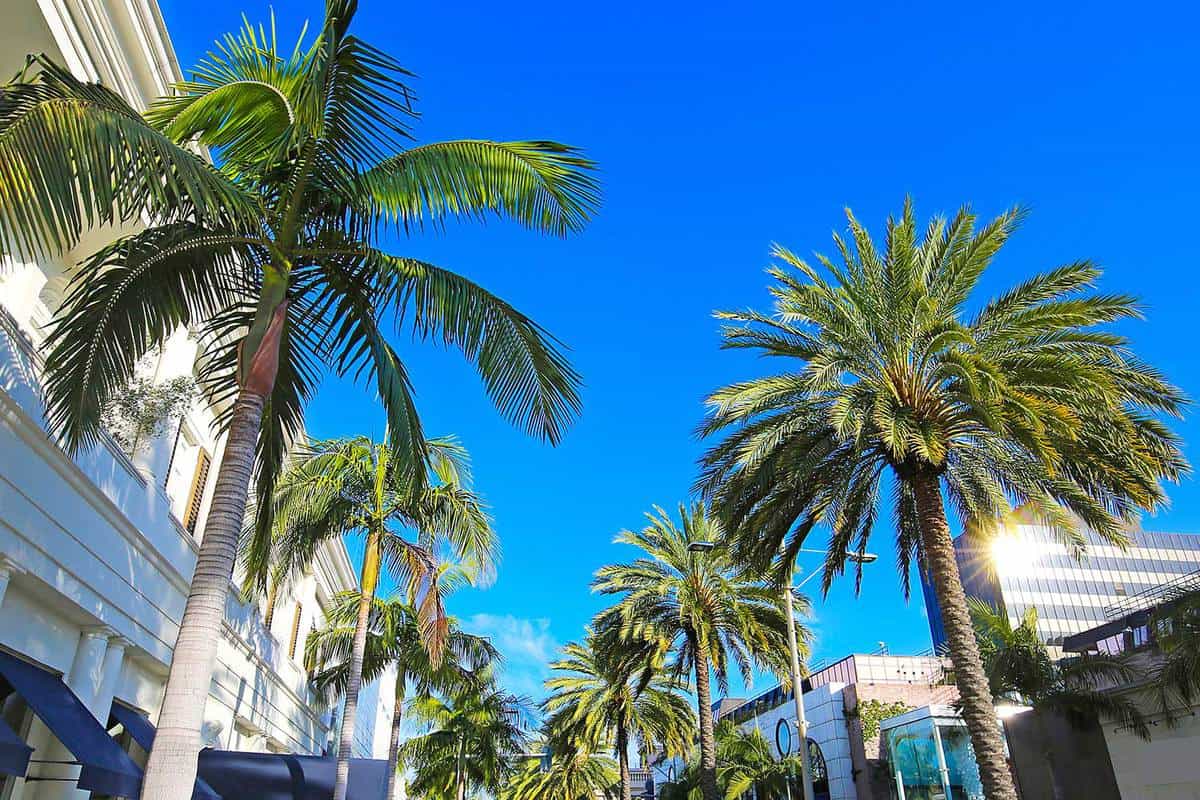California is almost as famous for its palm trees as it is for the celebrities who call it home. How, though, do average California residents go about caring for the palm trees they have on their properties?
Learning how to care for a palm tree will take time, but you'll be able to start on the right foot by taking the following steps:
- Planting your palm tree with care or professional guidance
- Watering frequently during the growing stage
- Using the right fertilizer
- Trimming your tree
Still feeling apprehensive? Let's break those steps down further so the palm trees on your property can thrive. With a little more information under your belt, you'll be able to care for some of California's most iconic palms confidently.
Contents
 How To Care For Palm Trees in California
How To Care For Palm Trees in California
So you've decided that you want to integrate one of California's iconic palms into your landscaping. Once you've chosen the species you want to have around, you'll need to take steps to ensure that it'll survive on your property.
How, though, do you go about caring for a California palm?
What You Need To Know About Palm Trees in California
Let's clear one thing up right away: there's more than one type of palm tree in California. Surprisingly, though, only one species is native to the area. The California fan palm grew in California long before people came to the area. It was only after residents decided to invest in terraforming and landscaping that palms from Mexico and other arid regions arrived in the area.
Some of the most popular palm trees in California today include:
- Jelly Palms
- Coconut Palms
- Hurricane or Princess Palms
- Bamboo Palms
- Spindle Palms
- Bottle Palms
- Triangle Palms
- Wild Date Palms
- Canary Island Date Palms
- Solitaire Palms
- Royal Palms
- Cocos Plumosas
- Miniature Royal Palms (or Christmas Palms)
- Mexican Fan Palms
- Areca Palms
You can bring any of these palm trees home with you after a trip to the nursery. Their care and keep will vary a little, but you'll be able to get away with a few essential staples, regardless of species.
Getting Started
Once you've brought your tree home, where do you start? Let's break your first steps down so you can give your palm the start it needs to thrive.

Plant Your Palm With Care
Different palm trees need different amounts of sun to thrive. Do your research before bringing your palm tree home to ensure that you don't accidentally plant a shade-loving palm in the brightest spot on your lawn.
If you're not comfortable choosing the place to plant your palm tree yourself, you can always reach out to a local professional. Nursery representatives in California who are willing to make house calls can help you dig, plant, and mulch your palm tree so that it the healthiest start possible.
Water Frequently During The Growing Stage
You wouldn't think trees that have long-adapted to California's dry summers would need to much water to thrive. Palm trees, however, need a lot of water during their first week after planting if they're going to stay alive. Try to water your palm tree every day for a full week after you've planted it. If you're under-watering your palm, you'll start to sees its existing palms turn yellow or wither in the sun.
Use the Right Fertilizer
You don't always need fertilizer to help your palm tree grow, but it never hurts to give your tree access to more nutrients. Fertilizing your palm tree will help the roots take hold in the ground, preventing the tree from falling over and ensuring that it gets as much water as it needs after the initial planting period has passed.
Find the best fertilizer for your palm tree on Amazon.
Trim Your Tree
Finally, as your tree grows, be prepared to trim back its fronds. You'll need to get used to trimming your palm for more than just aesthetic reasons. As your palm grows, you'll be able to help it properly direct the nutrients it takes in by trimming away fronds that are turning yellow or otherwise growing improperly. Likewise, if your palm gets infected by spider mites, trimming off the palm and hosing it down will help you keep it healthy.
Do your research ahead of time to determine whether or not the palm you want to bring home is self-cleaning. If it isn't, then it's up to you to inspect your tree for infestations and respond accordingly.
When your palm tree is still small, you'll be able to trim away yellowing fronds with a hand saw, as pictured below.
You can find a tree-trimming hand saw through Amazon.
As your palm tree gets older and taller, however, you're going to want to reach out to a professional to have its fronds trimmed. The cost of a professional trimming will vary based on many factors, including:
- Your palm's height
- The palm tree's condition
- The location of other trees on your property
Trees that are 30 feet or shorter tend to run you $300 per trim. Palms that grow past 60 feet are more expensive to care for and can run you $1,200 per trim if they're especially prolific growers.
How Much Water Do Palm Trees Need in California?
As mentioned, the amount of water your palm tree is going to need will vary on its stage in life. Immediately after planting, you're going to want to water your palm every day for a week. After it's made it through the first week after its transplant, you can water it every other day.
After about three weeks of consistent watering, you can taper off your schedule. An established palm tree only needs water two to three times a week, depending on how much rain the area you're living in gets.
Why Does California have Palm Trees?

Nowadays, California's palm trees are one of the state's defining symbols. Why, though, did anyone plant palm trees in the area in the first place? Palm trees aren't all fruit trees, and the ones that thrive in California don't provide enough resources to be considered useful. Partner this with the minimal shade they offer, and palm trees don't seem to serve much of a point.
That, however, is a point within itself. We'll touch on the people who brought trees to California in a few sections, but the state's residents who built its cities as we now know them wanted to display their dominance over nature creatively and frivolously. Thus, the modern affiliation between California and the palm tree sprang to life.
Do Palm Trees Mesh Well With California's Native Trees?
If the vast majority of palm trees in California aren't native to the area, should they be considered invasive species? In general, no. While they're certainly not trees that would grow naturally in the area, the palm tree species that were brought to Los Angeles and other Californian cities don't disrupt the ecosystem of the other native palms and plants growing in the area. If their root systems grew more aggressively, then they'd be a force to be reckoned with. As it stands, though, California's iconic palm trees know how to play nice.
Where Did All The Palm Trees In Los Angeles Come From?
If most species of palm trees aren't native to Los Angeles and California at large, where did they come from? For answers, we need to time travel back to the eighteenth century.
At the time, Los Angeles was about as far from the sprawling city it is today as you could get. It's said that Franciscan missionaries were the first to bring palm trees like the Mexican fan palm and other non-native species into the plot where the city would eventually be. It wouldn't be until the start of the twentieth century, though, that engineers-turned-gardeners would see the chance to terraform Los Angeles' ecosystem as their opportunity to prove that humanity bore domination over nature.
It's not entirely clear why the missionaries or landscapers chose palm trees over any other type of tree (even though palm trees aren't technically a type of tree). Palms don't help with erosion, provide little shade, and only a few species grow any edible fruit. At best, it's guessed that palm trees' appearance in the Christian Bible drove their caretakers to foster their growth in Los Angeles. After all, what makes the City of Angels more angelic than one of the trees that thrived in the Garden of Eden?
Regardless of their origins or the motives of those who planted them, palm trees evoke the excitement and exoticism that keeps Los Angeles and the rest of California exciting. If you want to bring some of that flair to your front yard, why wait? So long as you've got the right tools and expertise at hand, you'll be able to grow a healthy and hearty palm tree at home.


